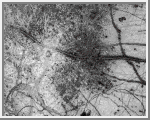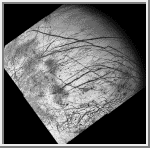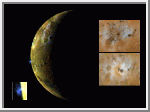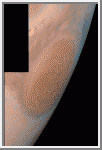Jupiter's Europa Harbors Possible "Warm Ice" or Liquid Water
 Tantalizing new images of Jupiter's moon Europa from
NASA's Galileo spacecraft indicate that "warm ice" or even
liquid water may have existed, and perhaps still exists today
beneath Europa's cracked icy crust.
Tantalizing new images of Jupiter's moon Europa from
NASA's Galileo spacecraft indicate that "warm ice" or even
liquid water may have existed, and perhaps still exists today
beneath Europa's cracked icy crust.
 The Europa results are one of several new Galileo
findings, including an image of a huge erupting geyser-like
volcano on Jupiter's moon Io and new information about
Jupiter's Great Red Spot, released today in a news briefing
at NASA's Jet Propulsion Laboratory (JPL), Pasadena, CA.
The Europa results are one of several new Galileo
findings, including an image of a huge erupting geyser-like
volcano on Jupiter's moon Io and new information about
Jupiter's Great Red Spot, released today in a news briefing
at NASA's Jet Propulsion Laboratory (JPL), Pasadena, CA.
Galileo scientists are poring over images that show
places on Europa resembling ice floes in Earth's polar
regions, along with suggestions of geyser-like eruptions and
details of long dark bands centered with white stripes that
stretch like interstate highways across Europa's face.
 "This moon is a marvelous place," said Dr. Ronald
Greeley, a Galileo imaging team scientist and a geologist at
Arizona State University, Tempe, AZ. "We're seeing evidence
of a lot of geological activity on Europa."
"This moon is a marvelous place," said Dr. Ronald
Greeley, a Galileo imaging team scientist and a geologist at
Arizona State University, Tempe, AZ. "We're seeing evidence
of a lot of geological activity on Europa."
"In some areas, the ice is broken up into large pieces that have shifted away from one another, but obviously fit together like a jigsaw puzzle," said Greeley. "This shows the ice crust has been or still is lubricated from below by warm ice or maybe even liquid water."
The results bring scientists a step closer to determining whether Europa has environmental "niches" warm enough and wet enough to meet the requirements to host life, Greeley said.
Europa is about the size of Earth's Moon and is covered largely with smooth white and brownish-tinted ice, instead of large craters like so many other bodies in the Solar System. Scientists believe its cracked cue-ball appearance is due to stressing caused by the contorting tidal effects of Jupiter's strong gravity. They speculate that the warmth generated by tidal heating may have been sufficient to soften or even liquefy some portion of Europa's icy covering.
Europa has long been considered by scientists and celebrated in science fiction as one of the handful of places in the Solar System (along with Mars and Saturn's moon Titan) that could possess an environment where primitive forms of life could possibly exist.
"A major goal of Galileo's studies of Europa is to search for signs of current or past activity to help answer the question: Is there a liquid zone on Europa?" said Greeley. "We are interested in identifying the time and places on Europa where liquid water might exist. We want to go back to some of these areas that suggest soft ice or liquid water under the ice and test some of the questions we're asking now."
The current images, taken from a distance of about 95,700 miles (155,000 kilometers), show features about one mile across (1.6 kilometer per pixel resolution). Moon flybys later in the mission will bring the Galileo spacecraft to within 370 miles (600 kilometers) of Europa's surface. During those flybys, the best resolution from the camera will average about 72 to 98 feet (22 to 30 meters- per-pixel) and as fine as 36 feet (11 meters) per pixel, so that objects the size of buildings on Earth could be discerned, Greeley said.
Galileo's close flybys of Europa will occur December 19, 1996, February 20, 1997 and November 6, 1997. Additional non-flyby observations will be made during this September and November, and in April, June and September of 1997.
Galileo's detailed images are shedding new light on the nearly global, highway-like stripes on Europa that scientists call "triple bands" because of their dark-bright- dark appearance. Originally discovered in data from NASA's Voyager spacecraft in 1979, the cracks are thought to reflect tidal stressing in Europa's icy crust. "The scale of fracture patterns -- extending a distance equivalent to the width of the western United States -- dwarf the San Andreas fault in length and width," said Greeley.
Planetary geologists have proposed several models that could be responsible for creating the banded roadway look of these features. One set of models calls for combinations of tectonic faulting and flooding caused by liquid water or warm ice mixed with darker silicates that well up through cracks and then freeze over.
Galileo scientists say the new data suggest another model where "dirty geysers" erupt along a line, ejecting a mixture of ice and darker silicate debris along the surface. This event may be followed by a more gentle, continuous flow of cleaner water ice that paints the white stripe down the center of the feature.
 In other mission results, one new Galileo image of
the moon Io shows a huge new blue-colored volcanic plume
extending about 60 miles (about 100 kilometers) into space.
Scientists believe the blue color of the plume coming from
the feature, called Ra Patera, is probably due to tiny
particles of sulfur dioxide "snow" that condense from the gas
as the plume expands and cools.
In other mission results, one new Galileo image of
the moon Io shows a huge new blue-colored volcanic plume
extending about 60 miles (about 100 kilometers) into space.
Scientists believe the blue color of the plume coming from
the feature, called Ra Patera, is probably due to tiny
particles of sulfur dioxide "snow" that condense from the gas
as the plume expands and cools.
 "This is very different from what we see with
volcanic eruptions on Earth," said Galileo project scientist
Dr. Torrence V. Johnson of JPL. "Terrestrial eruptions
cannot throw materials to such high altitudes. We believe
that on Io we are seeing geyser-like eruptions that are
driven by sulfur dioxide or sulfur gas that erupts and
freezes in Io's extremely tenuous atmosphere."
"This is very different from what we see with
volcanic eruptions on Earth," said Galileo project scientist
Dr. Torrence V. Johnson of JPL. "Terrestrial eruptions
cannot throw materials to such high altitudes. We believe
that on Io we are seeing geyser-like eruptions that are
driven by sulfur dioxide or sulfur gas that erupts and
freezes in Io's extremely tenuous atmosphere."
Galileo images have also shown that the Ra Patera plume glows in the dark, perhaps due to the fluorescence of sulfur and oxygen ions created by the breaking apart of sulfur dioxide molecules by energetic particles in the Jovian magnetosphere.
Comparing the Galileo Io images
with Voyager images
taken 17 years ago, scientists have found that Ra Patera is
the site of dramatic surface changes. An area around the
volcano about the size of the state of New Jersey (about
40,000 square kilometers) has been covered by new volcanic
deposits since 1979.
 Fresh Galileo images of Jupiter's
Great Red Spot show
new detail in the hurricane, which has been observed for at
least 300 years. Winds blow counterclockwise around the
Great Red Spot at about 250 miles per hour (400 kilometers
per hour). The size of the storm is more than one Earth
diameter (8,000 miles or 13,000 kilometers) in the north-south
direction and more than two Earth diameters in the
east-west direction. Galileo images are allowing scientists
to detect varying altitudes of clouds within and surrounding
the storm, and are showing new details in the structure of
the giant storm.
Fresh Galileo images of Jupiter's
Great Red Spot show
new detail in the hurricane, which has been observed for at
least 300 years. Winds blow counterclockwise around the
Great Red Spot at about 250 miles per hour (400 kilometers
per hour). The size of the storm is more than one Earth
diameter (8,000 miles or 13,000 kilometers) in the north-south
direction and more than two Earth diameters in the
east-west direction. Galileo images are allowing scientists
to detect varying altitudes of clouds within and surrounding
the storm, and are showing new details in the structure of
the giant storm.
Galileo's next flyby of a moon of Jupiter occurs September 6, 1996, when the spacecraft will come within 155 miles (250 kilometers) of the surface of Ganymede -- the largest moon in the Solar System. The spacecraft accomplished its first encounter of Ganymede on June 27 and found remarkable tectonic features on the big moon. September's flyby of Ganymede will be about 370 miles (about 600 kilometers) closer than Galileo's first encounter of that moon in the previous flyby, when the spacecraft flew 531 miles (855 kilometers) above the surface.
The Galileo mission is managed by JPL for NASA's Office of Space Science, Washington, DC.
Douglas Isbell
Headquarters, Washington, DC (August 13, 1996)
(Phone: 202/358-1753)
Mary Beth Murrill
Jet Propulsion Laboratory, Pasadena, CA
(Phone: 818/354-5011)
RELEASE: 96-164

 Jupiter
Jupiter